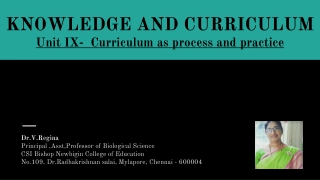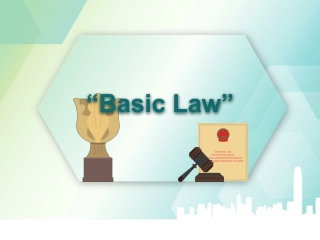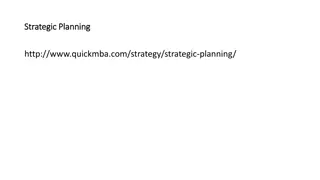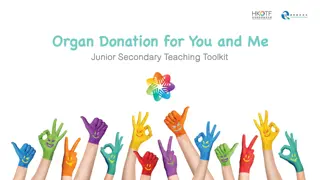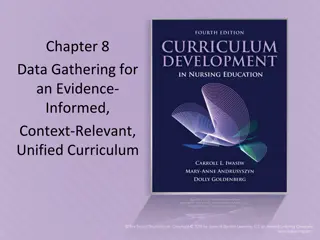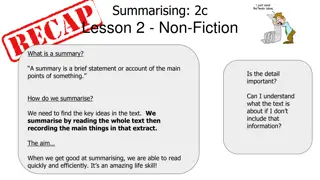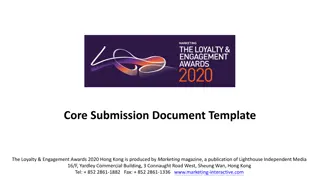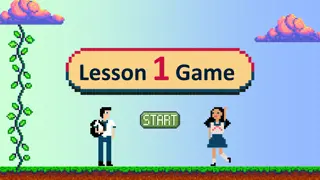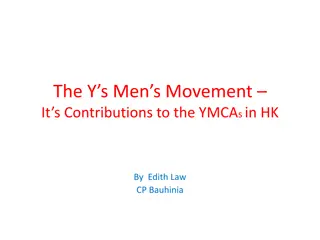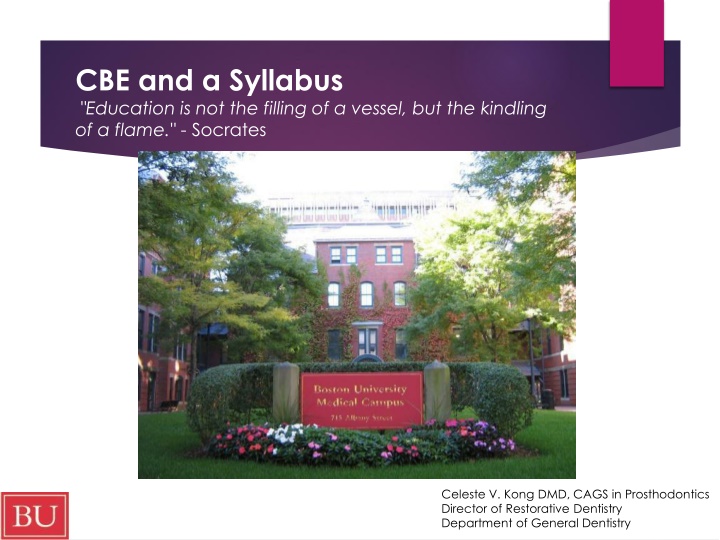
Competency Based Education in Learning and Syllabus Design
Explore the concept of Competency Based Education (CBE) as a performance-based approach focusing on mastering skills essential for societal functioning. Discover how CBE links course goals to competencies, incorporates feedback mechanisms, and emphasizes outcomes. Learn to create effective syllabi, design assessments, and evaluate learning objectives within the CBE framework.
Download Presentation

Please find below an Image/Link to download the presentation.
The content on the website is provided AS IS for your information and personal use only. It may not be sold, licensed, or shared on other websites without obtaining consent from the author. If you encounter any issues during the download, it is possible that the publisher has removed the file from their server.
You are allowed to download the files provided on this website for personal or commercial use, subject to the condition that they are used lawfully. All files are the property of their respective owners.
The content on the website is provided AS IS for your information and personal use only. It may not be sold, licensed, or shared on other websites without obtaining consent from the author.
E N D
Presentation Transcript
CBE and a Syllabus "Education is not the filling of a vessel, but the kindling of a flame." - Socrates Celeste V. Kong DMD, CAGS in Prosthodontics Director of Restorative Dentistry Department of General Dentistry
At the end of this presentation the participants: Will be able to define Competency Based Education Will be able to describe the different levels of learning in the cognitive domain. Will be able to apply Bloom s Taxonomy in a syllabus Will be able to differentiate between formative and summative evaluation Will be able to create a syllabus for a course/lecture Will be able to design a rubric Will be able to evaluate a colleague s learning objectives.
When designing a course keep in mind that Course Goals and Objectives always link back to a Competency
CBE: Competency Based Education It was defined by the U.S. Office of Education as a performance-based process leading to demonstrated mastery of basic and life skills necessary for the individual to function proficiently in society (U.S. Office of Education, 1978). Is based upon what the learner needs to be able to do upon completion of a program
CBE: Competency Based Education It focuses on the outcomes Knowledge, attitudes and skills It is adaptive to the learner, the teacher and the community
CBE Provides learners with immediate feedback on assessment performance Formative evaluation Paces instruction to learner needs Milestones Summative evaluation = Learner demonstrates mastery of specified competency statements Remediation Enrichment
Dreyfus model of skill acquisition Novice Beginner Competent Proficient Expert/Mastery The Economist : Dec 2005
Buried in literature How do we write a syllabus? http://www.bumc.bu.edu/fd/teac hing/course-development/
12 Elements of a Syllabus 1. Title Page 2. Table of Contents 3. Contact Information 4. Course Description Importance (significance for patient) Link to Medical Competencies Format (lecture, seminar, online) Prerequisites Learning Objectives (outcomes)
12 Elements of a Syllabus 5. Roles and Responsibilities for Learning 6. Schedule 7. Course Content : Topics 8. Assignments 9. Tips for Learning 10. Assessment 11. Student Evaluations of the course 12. Learning Resources
Elements of a LearningObjective: ABCD A. Audience : students, residents, colleagues Behavior : verb C. Condition : in class, in seminar, online Degree: to what degree do we expect them to retain information or perform a skill . B. D. http://www.bu.edu/cms/www.bumc.bu.edu/fd/files/PDF/WritingLearningObjectivesWebFD.pdf
Blooms taxonomy revised by Anderson and Krathwohl 2001 :cognitive domain See handout with list of suggested verbs.
Examples of Assessment Vocabulary Based on Bloom's Taxonomy COGNITIVE DOMAIN Knowledge List, Describe, Catalog, Itemize, Define, Classify, Organize, Identify, Name, Show, Indicate, Explain, Read Comprehension Change, Infer, Outline, Propose, Replace, Modify, Summarize, Alter, Vary, Condense, Explain DESCRIPTIVE VERBS ASSESSMENT WORDS/PHRASES Who, What, Where, When, Why, How, How much, Which one, Describe..., Select.... Which facts/opinions?; What does this mean?; Outline the information in...; Restate in your own words...; Explain what is happening...; Summarize... What would happen if...; Explain the effects of...; What and how much would change... What conclusions can be drawn from...; What is the theme or main idea?; What is the relationship...; Which are the most important ideas?; What is the motive of... Make up, Choose, Create, Design, Plan Solve, Predict, Explain, Diagnose, Estimate, Plan, Project, Judge Application Examine, Compare, Contrast, Identify, Equate, Rank, Deduce Analysis Create, Brainstorm, Predict, Plan, Design, Set up, Imagine Judge, Rank, Determine, Critique, Defend, Conclude Synthesis Which is more important, moral, logical, appropriate, valid; Compare and contrast...; Critique... Evaluation http://www.warrenlocal.k12.oh.us/whs/literacy/BloomVocab.htm
At the end of this presentation the participants: Will be able to define Competency Based Education Will be able to describe the different levels of learning in the cognitive domain. Will be able to apply Bloom s Taxonomy in a syllabus Will be able to differentiate between formative and summative evaluation Will be able to write a syllabus for a lecture/course Will be able to design a rubric Will be able to evaluate a colleagues learning objectives.
Assessment What multiple measures will we be using to assess our students performance?
Formative Evaluation Ongoing assessments or reviews of a student s performance that take place in the classroom, the lab or the clinic Some advocate for frequent short tests It is immediate (we start with the positive) Students can monitor their progress We use it to improve instructional methods It is often ungraded ( in the dental school) http://fcit.usf.edu/assessment/basic/basica.html
Skills Test Evaluates a specific skill e.g. evaluates a person s ability to draw blood, prepare a tooth for a crown, perform an interview , give a presentation They are not competency tests or summative evaluations when they stand alone.
Summative Evaluation Used to make a judgment of a student s competency at the end of the course A Final exam Case based questions/papers Portfolios Licensing exams Uses multiple measures.
Eportfolios to Make Learning Visible Students of the Facebook and Twitter generation know what it means to share ideas and reflections Multimedia Access can be limited to the teacher, group mates, class or even go public to be used for job interviews Submissions, comments, directions, evaluations can occur on the web site and made visible to the parties involved Teaching portfolios make visible the reflection and teaching philosophies of the instructor along with the evidence of their work and their students progress towards competency
Rubrics Establish clear guidelines for Evaluation and define the criteria that differentiate levels of performance
Rubric Development First Step C.Kong DMD BUSDM
Rubric contains 3 items* A Scale of the levels of performance e.g. novice, developing, competent, excellent The Dimensions or Evaluative Criteria or what are we evaluating. e.g. infection control, patient management Quality descriptions of each of the criteria. e.g. differentiate between what is excellent and needs improvement *Steven DD, Levi AJ. Introduction to Rubrics. Sterling, VA: Stylus Publishing, 2005
Presentation Rubric: https://celop.bu.edu/groups/ccf10/wiki/bb35a/Presentation_Rubric.html 1 2 3 4 Total Audience cannot understand presentation because there is no sequence of information. Audience has difficulty following presentation because student jumps around. Student presents information in logical, interesting sequence which audience can follow. Student presents information in logical sequence which audience can follow. Organization Student is uncomfortable with information and is able to answer only rudimentary questions, but fails to elaborate. Student demonstrates full knowledge (more than required) by answering all class questions with explanations and elaboration. Student does not have grasp of information; student cannot answer questions about subject. Student is at ease and answers most questions with explanations and some elaboration. Subject Knowledge Student occasionally uses visual aids that rarely support the presentation. Student uses superfluous visual aids or no visual aids. Student's visual aids explain and reinforce the presentation. Student's visual aids relate to the presentation. Visual Aids Student occasionally uses eye contact, but still reads mostly from notes. Student maintains eye contact with audience, seldom returning to notes. Student makes no eye contact and only reads from notes. Student maintains eye contact most of the time but frequently returns to notes. Eye Contact Student mumbles, incorrectly pronounces terms, and speaks too quietly for audience in the back of class to hear. Student uses a clear voice and correct, precise pronunciation of terms so that all audience members can hear presentation. Student's voice is low. Student incorrectly pronounces terms. Audience members have difficulty hearing presentation. Student's voice is clear. Student pronounces most words correctly. Most audience members can hear presentation. Verbal Techniques Total Points:
Summary Goals and Objectives link back to the competency statements Goals and objectives must be measurable Formative evaluation allows for the student to get immediate feedback and understand if they are at the correct milestone for developing their skill set. Skills tests make up only a portion of the total evaluation Rubrics must be outlined and included in the syllabus Summative evaluation requires multiple measures Eportfolios may be a comprehensive tool used for evaluation that is suited to the lifestyles of our students
Use of social media http://www.youtube.com/watch?v=QzZyUaQvpdc &feature=related
Other References Prideaux D. ABC of Learning and Teaching in Medicine. Curriculum Design BMJ 2003 ; 326:268-270 Steven DD, Levi AJ. Introduction to Rubrics. Sterling, VA: Stylus Publishing, 2005 Boston University School of Medicine (instructions on how to write a syllabus) http://www.bumc.bu.edu/fd/teaching/course- development/ University of Minnesota ( Center for Teaching and Learning) http://www1.umn.edu/ohr/teachlearn/tutorials/syllabus/w hat/index.html
Faculty Resource http://www.bumc.bu.edu/facdev- medicine/mentoring/ http://www.bumc.bu.edu/facdev- medicine/mentoring/ecfdp/ http://www.bumc.bu.edu/fd/teaching/course- development/ http://ww2.odu.edu/educ/roverbau/Bloom/blooms _taxonomy.htm

